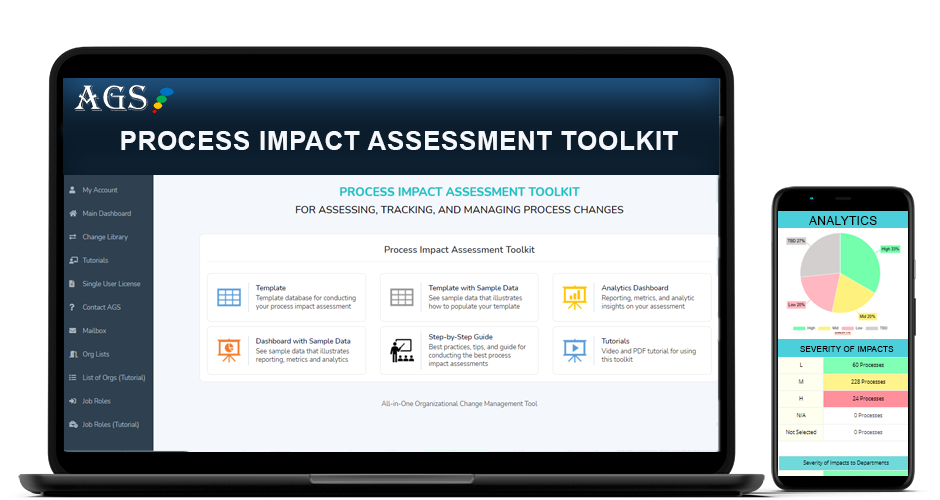BEST PROCESS IMPACT ASSESSMENT & ANALYSIS GUIDE
Everything You Need to Know about Conducting Process Impact Assessments, Including the Step-by-Step Tasks (How-to- Guide)
I have been a Sr Change Management Consultant for over 15 years and have led global transformations that impacted thousands of employees and customers across the Federal Reserve Bank, Intel, Apple, Capital One, Accenture, HSBC, Cisco, Deloitte, and many other organizations.
Throughout my years of experience, I have discovered that applying the best process impact analysis and management practices described below increases the success of change implementation by over 92%.
Ogbe Airiodion
Senior Change Management Consultant
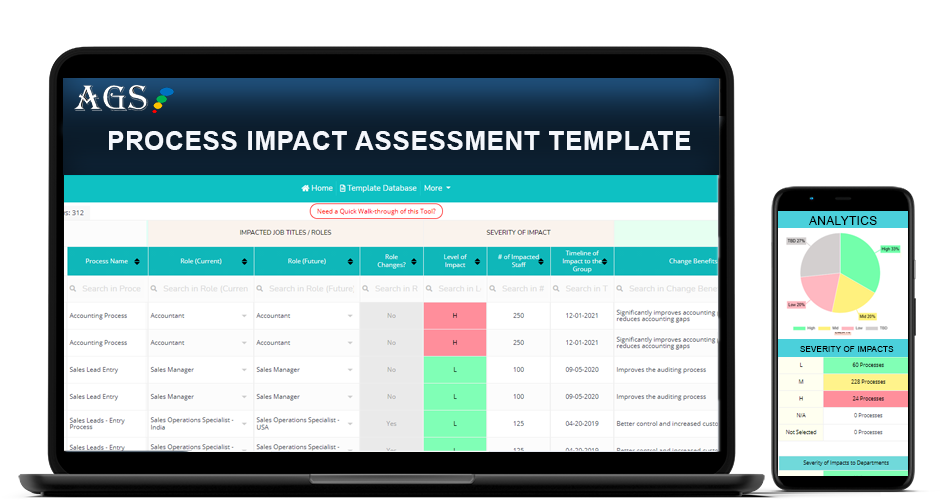
How-To Guide for Conducting Process Impact Analysis
This process impact analysis guide provides a step-by-step for conducting an assessment of the impacts a process change will have on an organization.
It is designed for Business Change Practitioners, HR Professionals, Project Managers, Program Leads, Consulting Firms, IT Professionals, Government Agencies, Corporations, Businesses, and many more for conducting an effective change impact analysis to identify processes that will be impacted by a change.
Before you can map out activities to help an organization transition successfully from one way of doing things to a completely new way of doing things (a process change), you need to know some important things:
- How is the process changing? (i.e., the “As-Is” versus the “To-Be”)
- Which organizational areas are being impacted? (i.e. which divisions, departments, and groups.)
- Which job roles are being impacted?
- What is the level of impact?
- What planning needs to take place for resistance management, training, & communications?
A process impact assessment is designed to help you answer all those questions so you can move into the next phase of your change management activities.
The information and answers from your process change impact analysis will drive your change management planning for supporting the change.
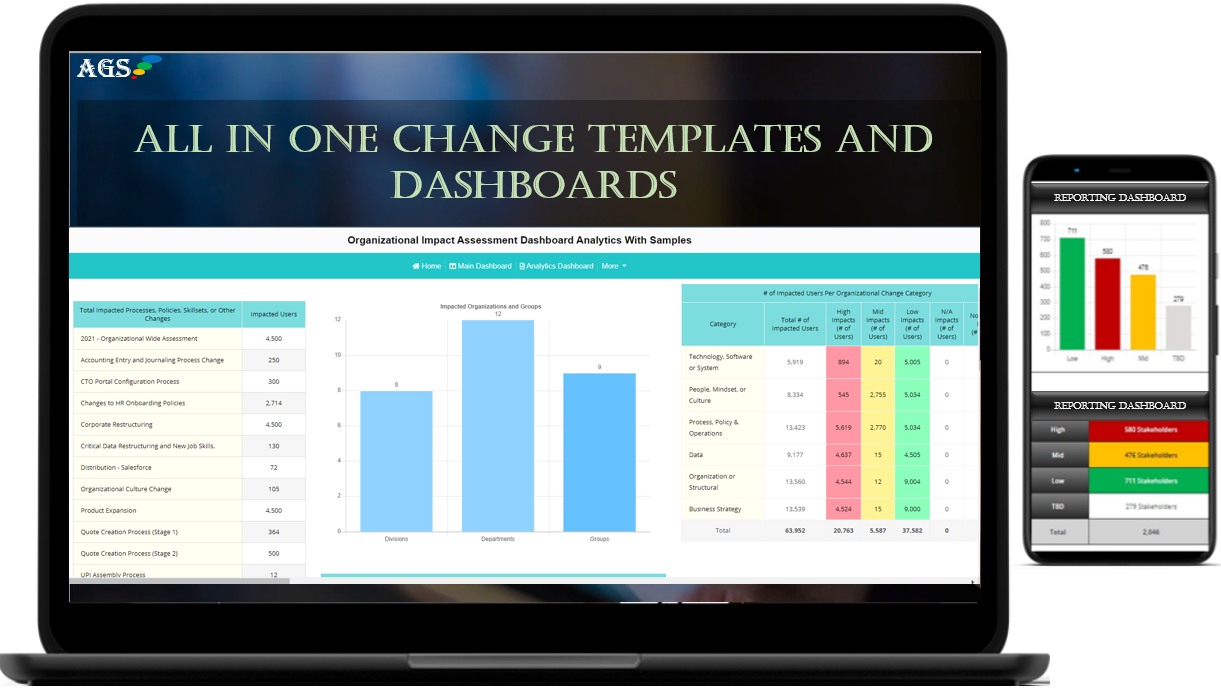
All-in-One Impact Assessments and Change Management Tools
Step-by-Step Process Impact Assessment, Including Templates and Samples
As noted, a process change impact assessment is a vital component for increasing the success of an organizational change. This assessment serves as a foundation for many other parts of the change management process (training, communications, resistance management, etc.).
This free guide provides you with a step-by-step overview and everything you need to know for conducting a best-in-class business process impact assessment.
Process changes often happen at a rapid pace within organizations. Many types of change (technology, organizational structure, etc.) will involve a change to some kind of process. For example, a move from using spreadsheets for accounting entries to a cloud-based account tool will involve a change of several processes that departments and job roles may use daily (inputting accounting entries, sending invoices, receiving payments, requesting quotes, etc.).
Keeping up with all those process changes can sometimes be frustrating, especially if you’re relying on outdated change impact analysis templates, frameworks, and tools that are manual and time-consuming.
It’s helpful to find tools that can streamline your work and make reporting activities easier. To support change practitioners and project management resources in their change impacts activities, this guide also references our best-in-class Change Impact Assessment Toolkit with Templates and Sample Data that you can leverage to enhance your change impact performance and save a lot of time.
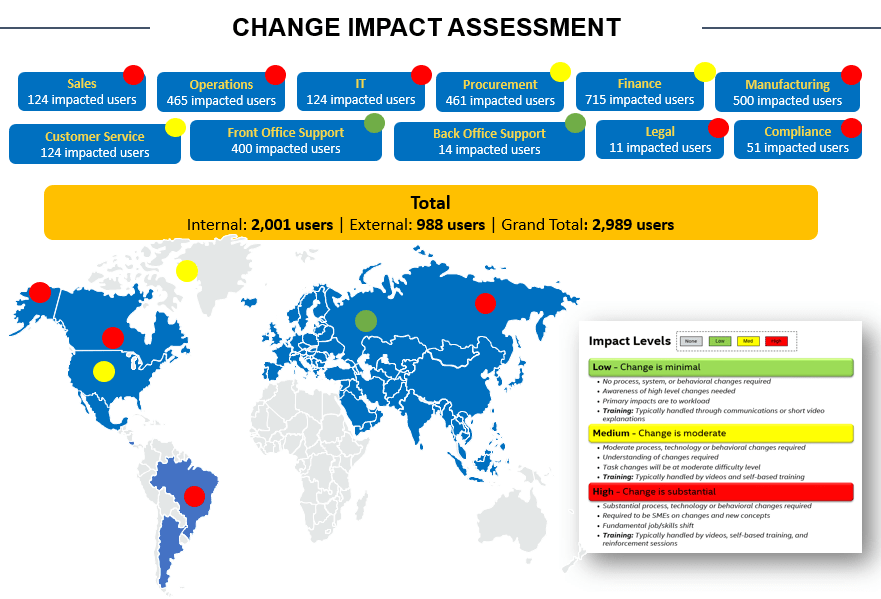
Impact Levels for Organizational Groups During a Process Change
What is a Business Process Change Impact Assessment?
A process change impact assessment is the set of tasks that you perform to analyze the impacts of a change of process on those within an organization or region. When an organization transforms its processes (the way something is done on a regular basis), there are individuals and groups that are impacted by this change.
Knowing who is going to be impacted, how they’re going to be impacted, and the severity of that impact is vital if you want to implement your organizational change management activities successfully.
Overview of what you’ll be doing when conducting a process impact assessment:
- Mapping out how exactly a process is changing for each process that will be altered.
- Identifying what impacts are happening from each process change.
- Based upon the process impacts, identifying which organizational areas (divisions, departments, groups, etc.) and which job roles will be impacted and thus need to change the way they do something.
- Identifying if the same job role or a different one will complete that process in the future.
- Evaluating the level of impact for each organizational group and job role (groups impacted at a higher level will need more engagement to help them transition).
- Identifying timing for the impacts
- Beginning your planning for resistance management by identifying the change benefits, which you’ll communicate to impacted users/employees/groups.
- Beginning your planning for training and communications needs (which you’ll then used as a foundation as you move onto those activities during the change management process).
“They always say time changes things, but you actually have to change them yourself.” – Andy Warhol
Process Impact Assessment Framework: What Information Do You Need to Gather for Your Impact Analysis?
When performing your process change impact analysis, it is vital that you apply a structured process impact assessment framework.
Key data points that you will need to gather as you conduct the impact analysis include reviewing process flows and mappings of the “As-Is” and “To-Be” processes. This means understanding in detail what the current state is now and how this is going to change to satisfy the needs of the change project.
Analyzing the process changes will help you identify the change deltas; in other words, what is changing between the current state and the future state.
You’ll also need to identify and document which groups and job roles will be impacted and the level or severity of the impact. Different groups and job roles often have differing levels of impact from a process change.
For example, if we revisit our scenario of the accounting department moving from using manual Excel sheets for accounting to a cloud accounting software, we could have the following impact levels:
- Accounting Department: High level of impact (It impacts just about every process they use.)
- Sales Department: Mid level of impact (It could change their quote process, but would not impact them as much as Accounting.)
- Shipping Department: Low level of impact (They may only have a slight change in process of creating a packing list for a shipment.)
Finally, you need to gather details on what the change management team needs to know. Such as, what types of communications are needed, what types of training topics need to be taught to the different impacted groups and job roles, etc.
Sample Process Impact Assessment Template
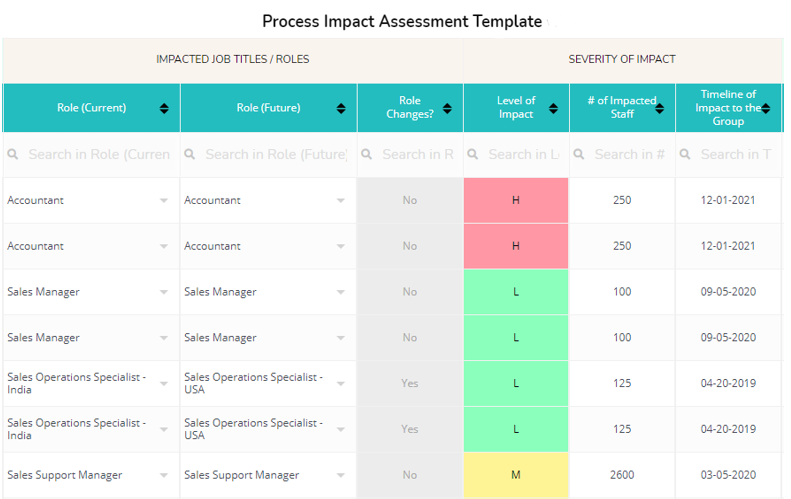
You can use our Process Impact Analysis Tool, to help. This tool is an online change manager that is designed to help you plan, manage, and execute a successful process impact assessment for a change project. Choose from a Cloud or Excel version that includes intelligent, real-time analytics and impact assessment samples. The toolkit gives you one place to enter all the details related to your process impact assessment.
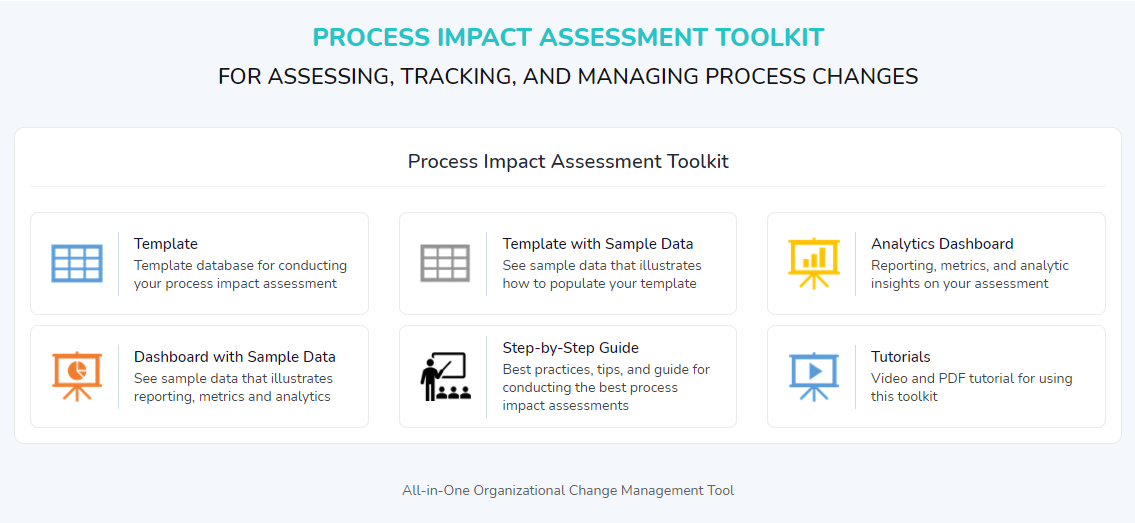
Process Impact Analysis Template & Tool
Why Is the Process Impact Assessment So Important?
The findings from your business process impact assessment are extremely important as this information will drive the development of your change management and project management strategies.
For example, the engagement, enablement, and communications needed to successfully drive an organizational change will be based upon the severity and scope of the impacts identified in the process impact assessment.
A higher level of change impacts to a specific group will mean a more comprehensive level of communication, training, coaching, and other engagement will be needed to increase that group’s buy-in and support of the change and the group’s ability to adopt the new process workflows necessary.
How Does a Process Impact Assessment Impact Other Change Processes?
- Informs the level of training needed for users/groups
- Informs the communications strategy for users/groups
- Helps identify where you need leadership & change agent support
- Gives insights on where you may expect the most resistance to the change
- Informs job role guides and documentation you’ll need to explain the new processes
Change Impact Reporting
Change impact reporting should provide an overview of your impact assessment to key project managers, critical stakeholders, change management team members, and others that are driving the change.
Some of the key elements you will want to include in your report on process change impacts are:
- Read out of the list of process changes and how many users are impacted by each process change
- Overview of the number of impacted organizational areas (e.g., division, department, group)
- List of all impacted organizational areas and job roles
- The severity of impact level for your organizational areas and job roles
- How many job roles are changing due to the process change and what those job roles are
- Read out of various due dates, such as training delivery due date, communication delivery due date, etc.
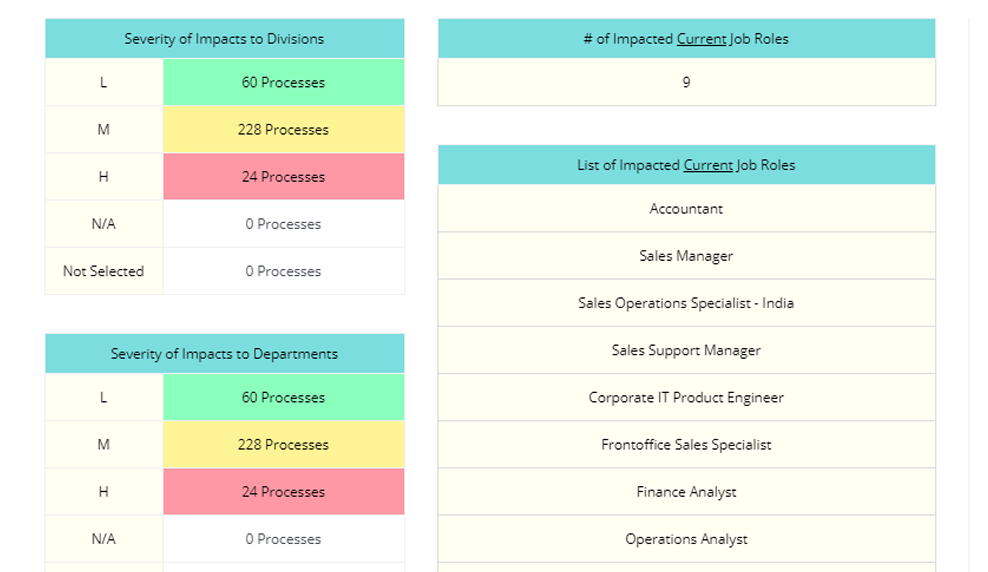
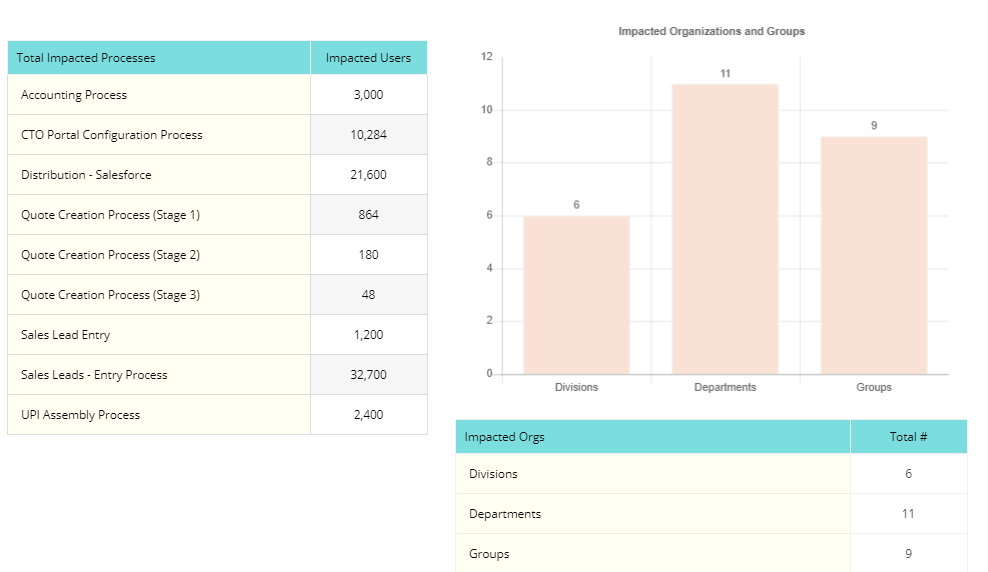
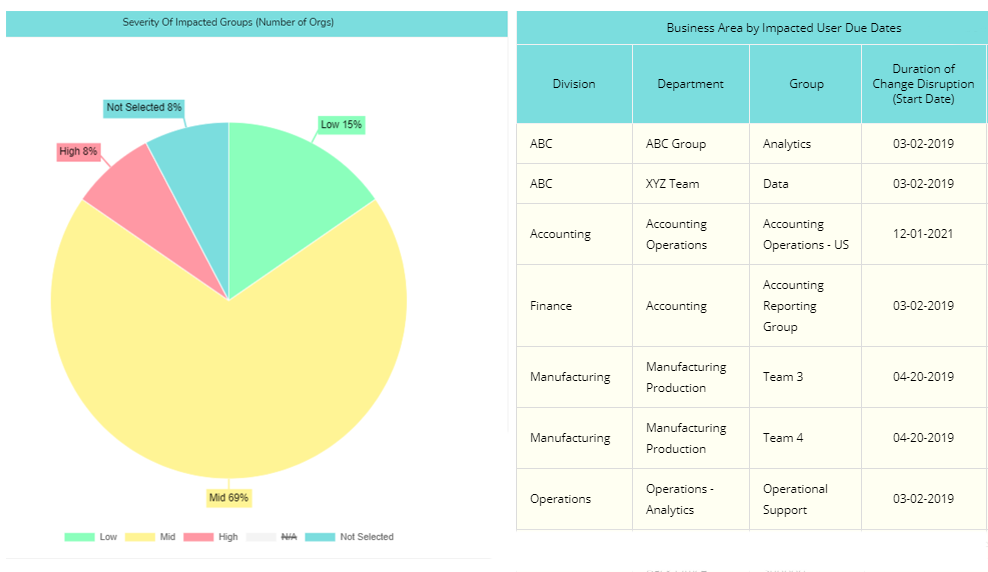
OCM Solution Process Impacts Tool – Analytics Dashboard (Real-Time)
Framework & Methodology for Conducting a Process Impact Assessment
It’s important to have a game plan when conducting a process impact assessment. This “game plan” is in the form of a change framework and methodology. This ensures consistency in performing impact assessments across multiple projects and process changes. Plus, having that framework in place makes your job a lot easier!
In the next section, we’ve provided a list of steps to take for conducting an effective process impact assessment for organizational process changes. But first, let us quickly summarize an industry-standard process change impact analysis framework that you can apply when doing your impact analysis.
A process change impact analysis is the act of comparing the current state (As-Is) to the future state (To-Be) and then identifying what is changing, who is impacted, what processes and tools will be impacted, and the severity of impact to people, processes and tools.
As you conduct your process impacts review and analysis, keep in mind that you must capture the current state and the future state and then document in detail what is being changed within the process.
See the below image for a simple change impact assessment framework and methodology that you can leverage for your purposes.
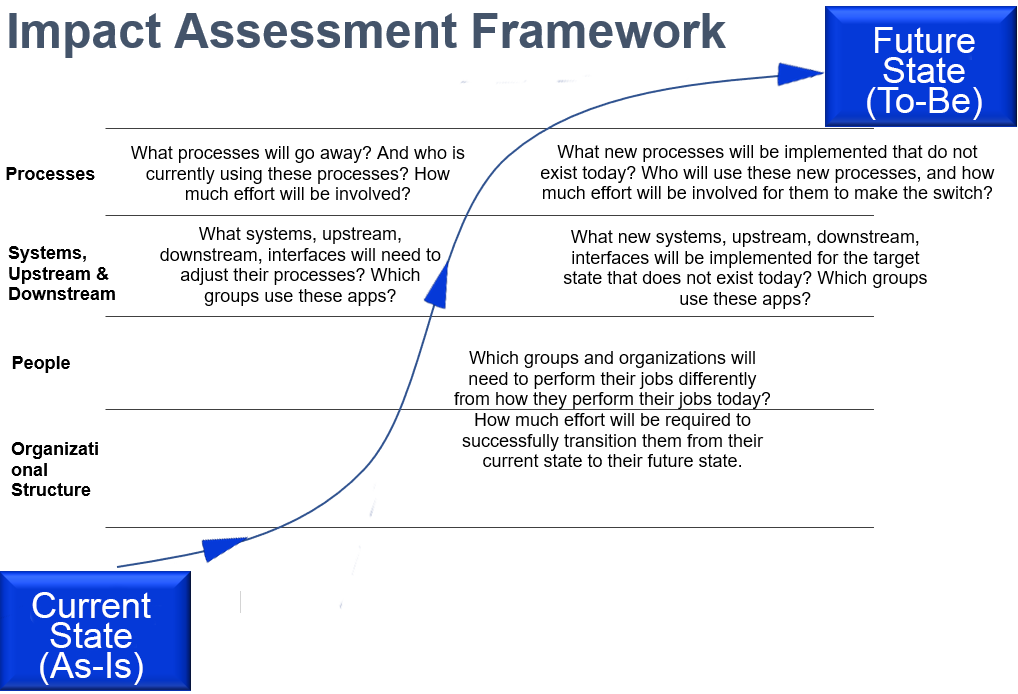
Comprehensive process impact assessment framework
When conducting process change impact assessments, you should gather details on the process flows as they are now and how they will be in the future, along with any documentation (guides, handbooks, project assessment presentation, etc.) related to both the “As-Is” and the “To-Be” for the changing processes. You’ll then enter this information into your process impact assessment template – Excel or online.
If you are creating your own change impact assessment matrix from scratch using Excel, Google Sheets, or some other spreadsheet, make sure that your impact template includes a column for listing the relevant future state processes and another column for capturing the differences (the delta). It should be similar to the OCM Solution Process Impact Assessment Template which is based on best practices.
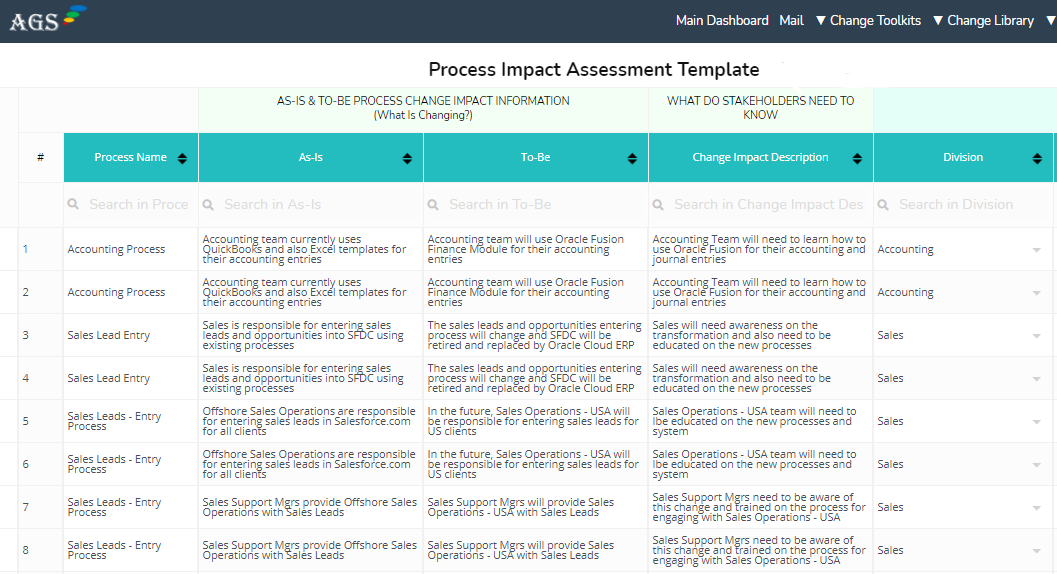
Process Impact Spreadsheet Template & Tool for Change Managers.
Steps for Conducting Your Process Change Impact Analysis
Step 1: Identify the Resources tasked with documenting the business and technical process flows.
Where you do find the information on the current “As-Is” and future “To-Be” processes so you can map impacts? You’ll need to identify the Resources in an organization that will have this information. Resources can be people, documentation, or online resources.
Business Analysts are often the Resources tasked with conducting process flow mappings. A process mapping involves documenting the end-to-end flow of the current state for a specific process. It also involves mapping out the future state processes as part of the future state design initiative.
However, your organization might be using the services of a consulting firm or resources within the business units to map out the respective business process flows, or this task might have been assigned to the project management team, technology/IT team, architect team, or some other group within the organization.
The first step for you to complete will be to identify the Resources that are responsible for documenting and mapping out the process flows.
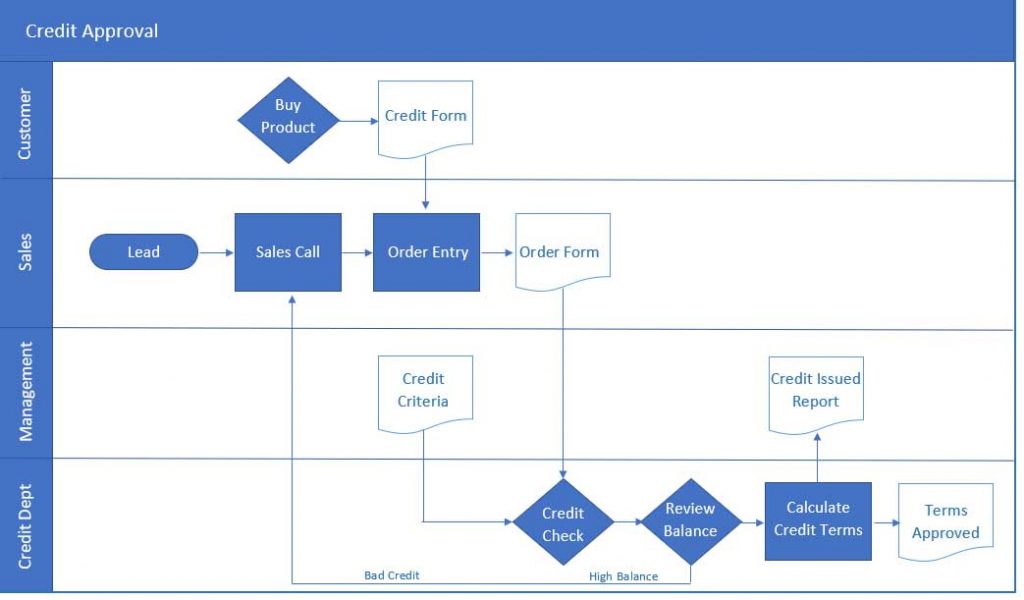
Sample process flows and mapping
In addition to the human Resources you’ve identified to meet with, you should look for the following types of documentation:
- Project Charter and Scope Document
- Design Planning Workshops
- Map Day Workshops
- Functional Decomposition & Architecture Diagrams
- Business Process Flows
- System User Lists
- and more…
Step 2: Conduct the process impact analysis
It is typically the role of the change management practitioner to perform the impact assessment. However, if you can encourage the Business Analysts performing the process flow documentation to also do the impacts assessments, that will free up your bandwidth to focus on other critical change management tasks.
If you are performing or leading the business process impact analysis, the following steps will take you through this part of the process.
- Gather As-Is and To-Be business process flows, technical flows, and other current and future state documentation from the Resources you’ve identified (i.e., project team, program sponsors, architects, existing documentation, etc.).
- Review the gathered documentation and populate the related sections of our Process Impact Assessment Template or another tool you may be using. If using our toolkit, you can leverage the end-to-end sample data that is included to increase your success.
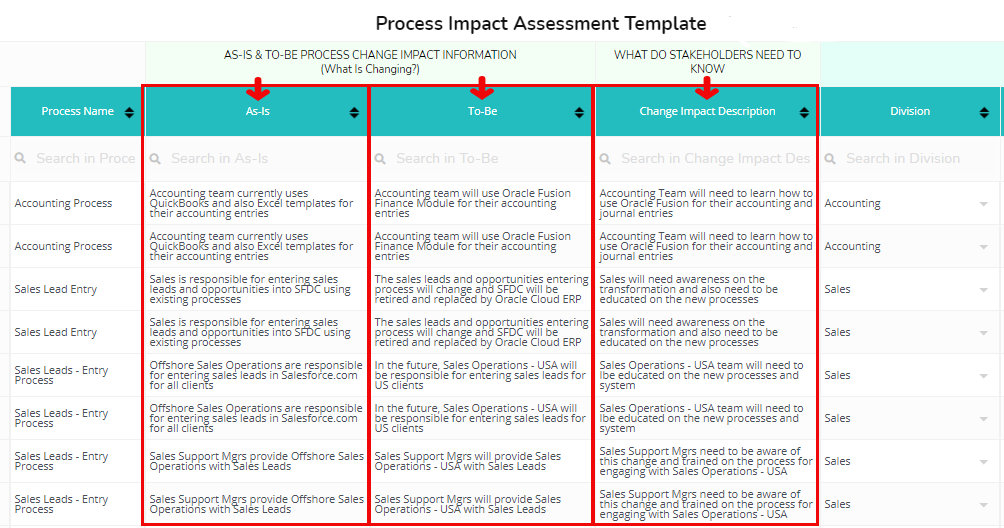
- Based upon the processes that are changing and the information you’ve gathered from the Resources, identify and enter the organizational areas (divisions, departments, and/or groups) that will be impacted by the changing processes.
- Identify and enter the job roles that will be impacted by the process changes, at this same time you can enter the number of users being impacted per each organizational area and job role. You want to be able to report on your number of job role changes and which job roles are changing.
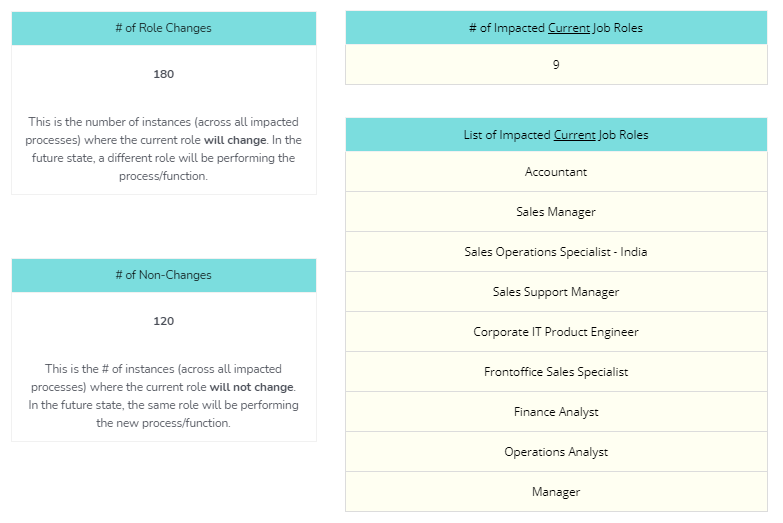
Example of the OCM Solution Process Impact Toolkit Analytics – Role Changes Report
- Identify the levels of impact for the organizational areas and job roles. You can get input from your Resources as well as Division or Department Managers.
- Conduct interviews with the project team, Work Stream Leads, architects, designers, stakeholders, and SMEs to get alignment and to ensure that you are capturing the right data.
- Start your change management planning by inputting details on the following elements that will inform other key areas of your change management:
- Change benefits (provides you with the “value statement” you’ll need to use for resistance management and in your communications)
- Training requirements (such as a list of training topics)
- Communication requirements (such as your communication types)
- Any associated due dates for projects, training, and communications
- Add any additional details, such as project name or notes
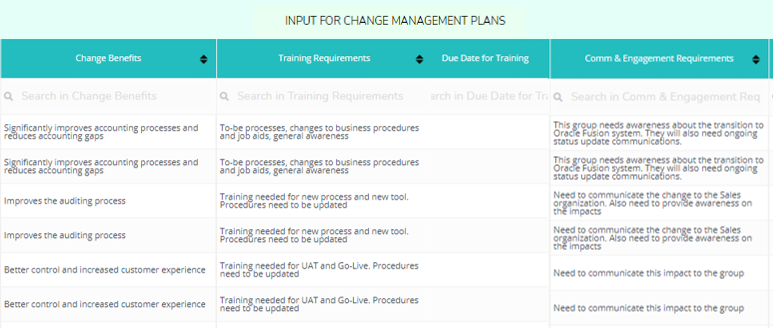
You should begin your change management planning during your process impact analysis.
Step 3: Final Steps: Change Impact Assessment Process
The final steps for completing your change impact assessment are listed below.
(3.1) Make sure to validate your change impact findings and output with the Project Team, Business Analysts, and Subject Matter Experts, as well as key stakeholders to get their feedback and integrate that into your template.
(3.2) Follow up with the stakeholders and teams that provided feedback to review and discuss the feedback that you have integrated to ensure that you have correctly reflected their input.
(3.3) Summarize the process impacts in a comprehensive presentation for leadership and impacted managers. Leaders do not like to digest a ton of information during a meeting, and so you should use a comprehensive and consolidated presentation structure. Use the free Change Management Strategic Playbook that comes with your OCM Solution Process Impact Assessment Toolkit for an easy-to-use way to present your findings.
(3.4) Present the impacts to senior leaders, the steering committee, and other program leaders, and also discuss the next steps.
(3.5) Based on the findings from your process impact analysis, you will next need to develop your training program, as well as your communications and engagement activities. Not every process change will require a training or engagement program. The severity and scale of the impacts will inform the change deliverables that you need to develop to ensure a successful change process.
Top Process Change Impact Assessment Toolkit & Template
When conducting your organizational change impact analysis, it is imperative that you use software, an impact analysis tool, or a process impact management spreadsheet to document the current state, the future state, and what is changing.
As mentioned above, you can try to develop a process impact documentation matrix or spreadsheet by yourself. If so, make sure that you include fields to document the severity of the impacts, which groups and job roles are impacted, and when they will be impacted, as well as change management requirements.
Or you can save time and ensure all your bases are covered by using our Process Impact Assessment Tool. This tool includes a best-in-class impact assessment template database, sample data, a 360-degree analytics view of impacted groups, and much more that you can leverage to simplify and optimize your change impact performance.
Our platform is a full-featured cloud platform to help you plan, manage, and execute a successful change project, end-to-end, whether this is your first change project or your one-hundredth.
Click below to purchase this tool and for instant access that will allow you to get started right away.
Process Impact Assessment Toolkit
An impact assessment is an end-to-end analysis of how a business change or project will impact people, processes, tools, and job functions.
Impact analysis steps include gathering current state and future state process flows, and assessing what is changing (change delta), and then identifying the impacted groups, processes, tools, and jobs.
A process change impact analysis matrix is a structured spreadsheet used to document As-Is and To-Be processes, as well as what is changing (the change delta between the current and future state). An impact analysis matrix also includes columns for documenting the impacted teams, groups, divisions, organizations, job functions, and other impacts-related information.
How do you define change impact assessments? An impact assessment is basically comparing two states (the current state and the future state) of a change to identify what is changing, who is impacted by that change, and what do the impacted users need to know.
A process impact assessment, is the process used to evaluate the impacts of a process change, including the who, what, when and how: who is impacted, what is impacted, when will they be impacted, and how will they be impacted.What is an Impact Assessment?
What are Impact Analysis Steps?
What is an Impact Analysis Matrix?
Change Impact Assessment Definition
What is a Process Impact Assessment?
Note: Content on OCM Solution's ocmsolution.com website is protected by copyright. Should you have any questions or comments regarding this OCM Solutions page, please reach out to Ogbe Airiodion (Change Management Lead) or the OCM Solutions Team today. OCM Solution was previously known as Airiodion Global Services (AGS).
External image source/attribute: support.content.office.net/en-us/media/60e49196-5913-4481-ba29-3479fa0dc97e.png, https://www.ls.graphics/free/free-pixel-4-and-pixelbook-go-mockup

